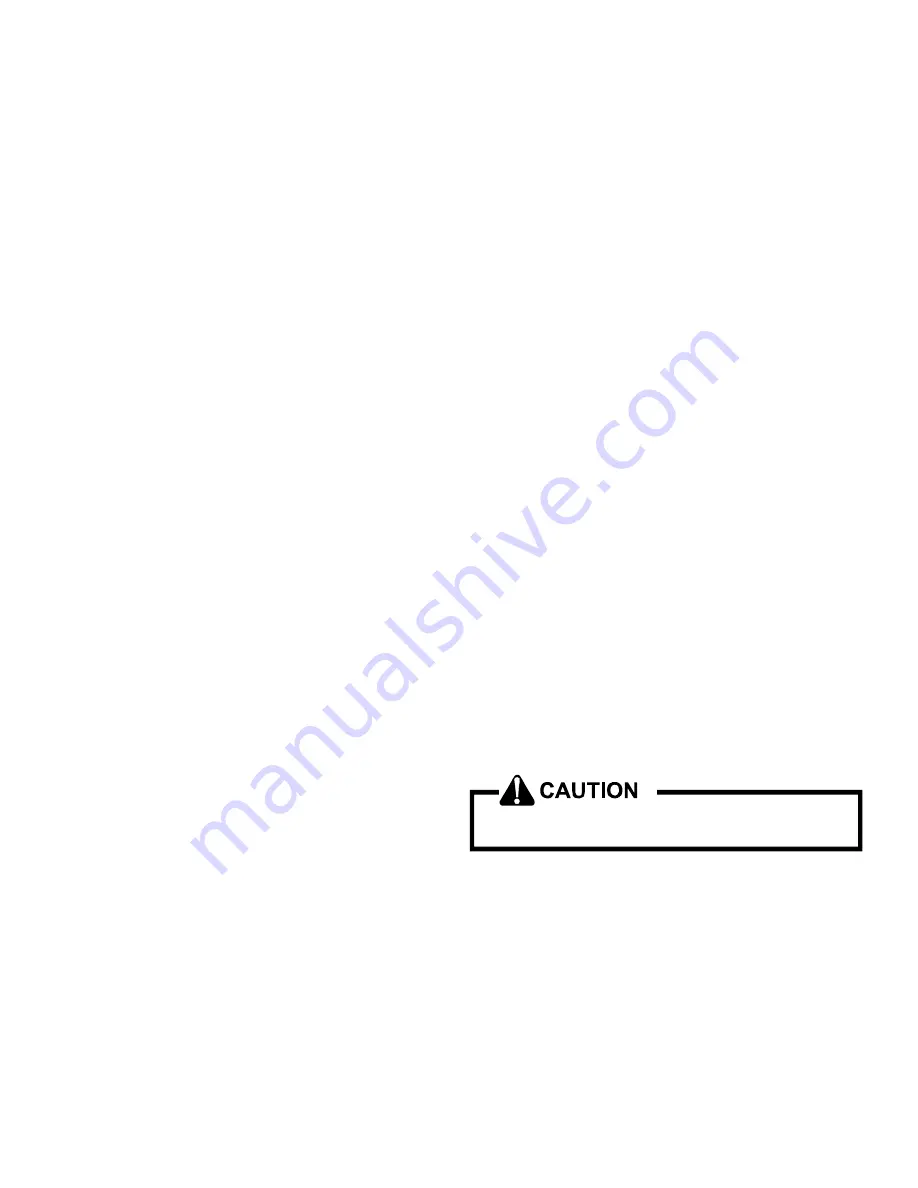
SERVICING
43
Since the high side pressure rises faster when the tempera-
ture increases, more refrigerant flows to the evaporator, increas-
ing the cooling capacity of the system.
When the outdoor temperature falls, the reverse takes place.
The condensing pressure falls, and the cooling loads on the
indoor coil decreases, causing less refrigerant flow.
A strainer is placed on the entering side of the tube to prevent
any foreign material from becoming lodged inside the fixed ori-
fice restriction device.
If a restriction should become evident, proceed as follows:
1. Recover refrigerant charge.
2. Remove the orifice or tube strainer assembly and replace.
3. Replace liquid line drier, evacuate and recharge.
CHECKING EQUALIZATION TIME
During the "OFF" cycle, the high side pressure bleeds to the
low side through the fixed orifice restriction device. Check
equalization time as follows:
1. Attach a gauge manifold to the suction and liquid line dill
valves.
2. Start the system and allow the pressures to stabilize.
3. Stop the system and check the time it takes for the high
and low pressure gauge readings to equalize.
If it takes more than seven (7) minutes to equalize, the restric-
tion device is inoperative. Replace, install a liquid line drier,
evacuate and recharge.
S-112 CHECKING RESTRICTED LIQUID LINE
When the system is operating, the liquid line is warm to the
touch. If the liquid line is restricted, a definite temperature
drop will be noticed at the point of restriction. In severe cases,
frost will form at the restriction and extend down the line in the
direction of the flow.
Discharge and suction pressures will be low, giving the ap-
pearance of an undercharged unit. However, the unit will have
normal to high subcooling.
If a restriction is located, replace the restricted part, replace
drier, evacuate and recharge.
S-113 REFRIGERANT OVERCHARGE
An overcharge of refrigerant is normally indicated by exces-
sively high head pressure and/or liquid return to the compres-
sor.
Evaporator coils with a
fixed orifice
metering device could
allow refrigerant to return to the compressor under extreme
overcharge conditions.
If high head pressure is not indicated, an overcharge or a sys-
tem containing non-condensables could be the problem.
If overcharging is indicated:
1. Start the system.
2. Remove small quantities of gas from the suction line dill
valve until the head pressure is reduced to normal.
3. Observe the system while running a cooling performance
test, if a shortage of refrigerant is indicated, then the sys-
tem contains non-condensables. See S-114 Non-
Condensables.
S-114 NON-CONDENSABLES
Check for non-condensables.
1. Shut down the system and allow the pressures to equalize
for a minimum of 15 minutes.
2. Take a pressure reading.
3. Compare this pressure to the temperature of the coldest
coil since this is where most of the refrigerant will be. If the
pressure indicates a higher temperature than that of the
coil temperature, non-condensables are present.
To remove the non-condensables.
1. Remove the refrigerant charge.
2. Replace and/or install liquid line drier
3. Evacuate and recharge.
S-115 COMPRESSOR BURNOUT
When a compressor burns out, high temperature develops caus-
ing the refrigerant, oil and motor insulation to decompose form-
ing acids and sludge.
If a compressor is suspected of being burned-out, attach a
refrigerant hose to the liquid line dill valve and properly remove
and dispose of the refrigerant.
Now determine if a burn out has actually occurred. Confirm by
analyzing an oil sample using a Sporlan Acid Test Kit, AK-3 or
its equivalent.
Remove the compressor and obtain an oil sample from the
suction stub. If the oil is not acidic, either a burnout has not
occurred or the burnout is so mild that a complete cleanup is
not necessary.
If acid level is unacceptable the system must be cleaned by
using the cleanup drier method.
Do not allow the sludge or oil to contact the skin.
Severe burns may result.
Suction Line Drier Clean-up Method
Discard at least twelve (12) inches of the suction line immedi-
ately out of the compressor stub due to burned residue and
contaminates.
1. Remove compressor discharge line strainer, liquid line
strainer and/or drier and capillary tubes from indoor and
outdoor coils.
2.
Units with an expansion valve coil,
remove the liquid line
drier and expansion valve.
3. Purge all remaining components with dry nitrogen or car-
bon dioxide until clean.
4. Install new components including liquid liner drier.
5. Install suction line drier.

![Preview for 29 page of Goodman [A/G]PG Service Instructions Manual](http://thumbs.mh-extra.com/thumbs/goodman/a-g-pg/a-g-pg_service-instructions-manual_2243406-29.webp)
![Preview for 30 page of Goodman [A/G]PG Service Instructions Manual](http://thumbs.mh-extra.com/thumbs/goodman/a-g-pg/a-g-pg_service-instructions-manual_2243406-30.webp)
![Preview for 31 page of Goodman [A/G]PG Service Instructions Manual](http://thumbs.mh-extra.com/thumbs/goodman/a-g-pg/a-g-pg_service-instructions-manual_2243406-31.webp)
![Preview for 32 page of Goodman [A/G]PG Service Instructions Manual](http://thumbs.mh-extra.com/thumbs/goodman/a-g-pg/a-g-pg_service-instructions-manual_2243406-32.webp)
![Preview for 33 page of Goodman [A/G]PG Service Instructions Manual](http://thumbs.mh-extra.com/thumbs/goodman/a-g-pg/a-g-pg_service-instructions-manual_2243406-33.webp)
![Preview for 34 page of Goodman [A/G]PG Service Instructions Manual](http://thumbs.mh-extra.com/thumbs/goodman/a-g-pg/a-g-pg_service-instructions-manual_2243406-34.webp)
![Preview for 35 page of Goodman [A/G]PG Service Instructions Manual](http://thumbs.mh-extra.com/thumbs/goodman/a-g-pg/a-g-pg_service-instructions-manual_2243406-35.webp)
![Preview for 36 page of Goodman [A/G]PG Service Instructions Manual](http://thumbs.mh-extra.com/thumbs/goodman/a-g-pg/a-g-pg_service-instructions-manual_2243406-36.webp)
![Preview for 37 page of Goodman [A/G]PG Service Instructions Manual](http://thumbs.mh-extra.com/thumbs/goodman/a-g-pg/a-g-pg_service-instructions-manual_2243406-37.webp)
![Preview for 38 page of Goodman [A/G]PG Service Instructions Manual](http://thumbs.mh-extra.com/thumbs/goodman/a-g-pg/a-g-pg_service-instructions-manual_2243406-38.webp)
![Preview for 39 page of Goodman [A/G]PG Service Instructions Manual](http://thumbs.mh-extra.com/thumbs/goodman/a-g-pg/a-g-pg_service-instructions-manual_2243406-39.webp)
![Preview for 40 page of Goodman [A/G]PG Service Instructions Manual](http://thumbs.mh-extra.com/thumbs/goodman/a-g-pg/a-g-pg_service-instructions-manual_2243406-40.webp)
![Preview for 41 page of Goodman [A/G]PG Service Instructions Manual](http://thumbs.mh-extra.com/thumbs/goodman/a-g-pg/a-g-pg_service-instructions-manual_2243406-41.webp)
![Preview for 42 page of Goodman [A/G]PG Service Instructions Manual](http://thumbs.mh-extra.com/thumbs/goodman/a-g-pg/a-g-pg_service-instructions-manual_2243406-42.webp)
![Preview for 43 page of Goodman [A/G]PG Service Instructions Manual](http://thumbs.mh-extra.com/thumbs/goodman/a-g-pg/a-g-pg_service-instructions-manual_2243406-43.webp)
![Preview for 44 page of Goodman [A/G]PG Service Instructions Manual](http://thumbs.mh-extra.com/thumbs/goodman/a-g-pg/a-g-pg_service-instructions-manual_2243406-44.webp)
![Preview for 45 page of Goodman [A/G]PG Service Instructions Manual](http://thumbs.mh-extra.com/thumbs/goodman/a-g-pg/a-g-pg_service-instructions-manual_2243406-45.webp)
![Preview for 46 page of Goodman [A/G]PG Service Instructions Manual](http://thumbs.mh-extra.com/thumbs/goodman/a-g-pg/a-g-pg_service-instructions-manual_2243406-46.webp)
![Preview for 47 page of Goodman [A/G]PG Service Instructions Manual](http://thumbs.mh-extra.com/thumbs/goodman/a-g-pg/a-g-pg_service-instructions-manual_2243406-47.webp)
![Preview for 48 page of Goodman [A/G]PG Service Instructions Manual](http://thumbs.mh-extra.com/thumbs/goodman/a-g-pg/a-g-pg_service-instructions-manual_2243406-48.webp)
![Preview for 49 page of Goodman [A/G]PG Service Instructions Manual](http://thumbs.mh-extra.com/thumbs/goodman/a-g-pg/a-g-pg_service-instructions-manual_2243406-49.webp)
![Preview for 50 page of Goodman [A/G]PG Service Instructions Manual](http://thumbs.mh-extra.com/thumbs/goodman/a-g-pg/a-g-pg_service-instructions-manual_2243406-50.webp)
![Preview for 51 page of Goodman [A/G]PG Service Instructions Manual](http://thumbs.mh-extra.com/thumbs/goodman/a-g-pg/a-g-pg_service-instructions-manual_2243406-51.webp)
![Preview for 52 page of Goodman [A/G]PG Service Instructions Manual](http://thumbs.mh-extra.com/thumbs/goodman/a-g-pg/a-g-pg_service-instructions-manual_2243406-52.webp)

















